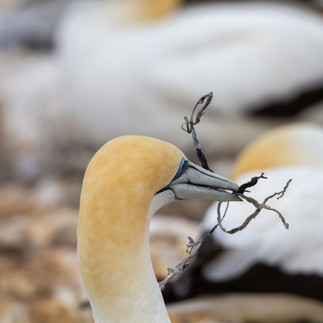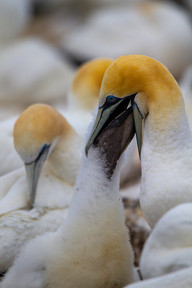
This is a gannet. On my first boat ride out to sea, I noticed this elegant white bird sweep effortlessly through the sky and then dive really fast headfirst into the water and my first thought was "Well that bird is a goner!" However, when the bird resurfaced, I was surprised and needed to know more about it. It quickly became a sight I looked forward to every time I was on a boat or near the coast. That bird was a Gannet.
From then onwards, it became my all time favourite bird.
Gannets can dive from almost 30 m heights at speeds that can reach 145 km/h.

When out on the boat looking for cetaceans (which means whales, dolphins and porpoises), we would look out for diving gannets as that would mean there was a large school of fish nearby. As a matter of fact we were not the only ones doing that, other marine animals also look out for diving gannets to find schools of fish. Gannets can dive from almost 30 m heights at speeds that can reach 145 km/h. To protect them from the impact of diving at such high speeds, they have special air sacs in their face and chest which act like cushions when they hit the water. Not to mention, their nostrils are located inside their mouths to avoid water going up into them.
Gannets nest in colonies, which, for some of us land dwelling mammals, is the only way to see one up close and fortunately, New Zealand boosts the largest gannet colony on the mainland in the world which is located at Cape Kidnappers.
When you get to a colony, you can smell the birds before you even see them! Courtship involves males, sometimes even females, getting bits of grass and seaweed to add to a large pizza sized nest which when covered with vast amounts of guano (bird poo) solidifies to form a cup shaped nest. While the nests are close together, the pairs are very territorial and while not hesitate to snap at anther bird that misses its targeted nest by even mere inches.

Gannets mate for life and when a bird from a pair comes back from whatever excursion it went on, The pairs greet each other with a ritualistic behaviour of head shaking, beak tapping and bowing. It looks like a complex and mesmerising dance and was by far the most impressive display I have seen. It is very elaborate and can last for minutes.
A pair will lay only 1 successful egg in a year. The chicks are born after around 45 days of incubation and so fluffeh!!!!! Both parents take turns to find food which they feed to the chick through incomplete regurgitation. After fledging, the chick, now a juvenile bird, makes the long journey across the Tasman Sea to Australia and won't return until after 3 years to find a mate and raise their own chicks in their ancestral nesting holes.

SO.... Gannets are #Awesome! We enjoyed watching the colony and can't wait to see more of these fascinating birds.





























Kommentare